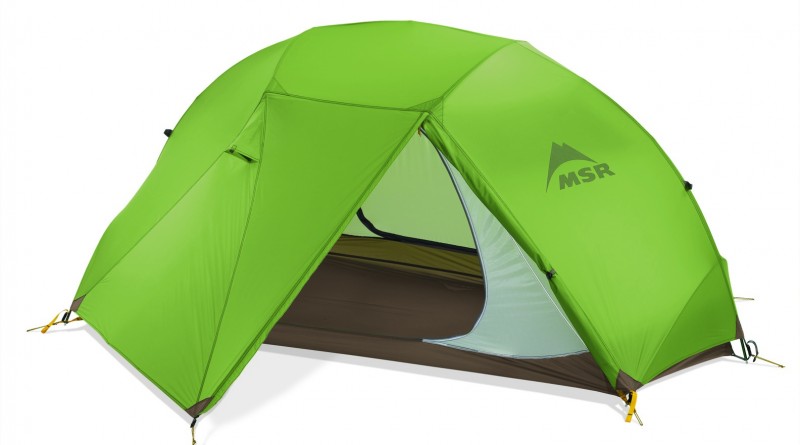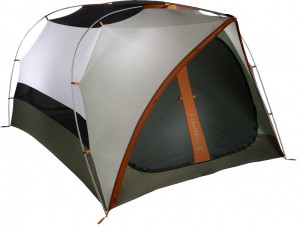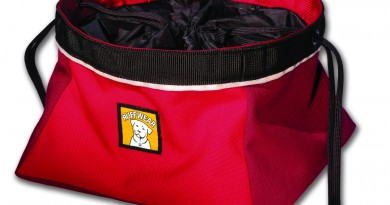Perfect Pitch: How to Choose the Right Tent for You
There are few things as renewing to the soul as a night spent sleeping outdoors—falling asleep to the sound of crickets and waking to the sound of birdsong.
Unless, that is, you wake up in an inch of water, surrounded by mosquitoes, or with your tent collapsed on top of you.
One of the biggest factors in determining the success of your camping trip depends on picking the right tent: too big, and you’re carrying extra weight; too small, and you might end up snuggling with a buddy who wants to keep it at “just friends.” A poorly constructed tent, or a tent assembled improperly, can allow rain inside. If the tent is designed for the cold backcountry, and you’re camping in the woods, you could be swimming in condensation.
There are hundreds of tents on the market. So how do you choose which one is right for you?
Josh “Grizz” Stephen, the Hard Goods Buyer at Outdoor Gear Exchange in Burlington, said the first question he asks people in the market for a tent is what they will be using the tent for—the purpose of the tent.
You won’t likely want to haul a two-person tent that weighs 10 pounds on a month-long backpacking trip on the Appalachian Trail. Typically, one can find tents that average about 2 pounds per person, sometimes even less. But be careful, because you may sacrifice durability with the weight reduction (and pay through the nose for the lightweight fabrics used in some construction). Generally, special features add weight, but you may decide some extra weight is worth it, says Stephen. For instance, an extra door can make the tent feel much bigger. He suggests two friends have a minimum of 32 to 34 square feet of space, while couples or others comfortable sleeping so close to each other can get away with less.
Paddlers and cyclists may be able to carry a bit more weight on their journeys—particularly if the paddlers won’t encounter too many portages along the way. The extra weight for more space might be worth it, if it ends up raining for a full day and you have to camp out for a while.
When you are car camping, you probably don’t need to factor weight into your decision as much. Let luxury be your guide in this case. If you’re camping with your family, you could splurge on extra space, so you can divide the tent into two areas—a sleeping area, and a living area, or an adult sleeping/living area, and a kids’ area, Stephen says.
‘Tis the Season
The next thing you’ll want to consider is the seasonality of the tent. Will you be using your tent in the dog days of summer in the deep South or at the foot of the Adirondacks in the middle of February? If you prefer camping in the warmer climates, look at three-season tents. These tents tend to incorporate fine mesh into some of the walls to prevent condensation from building up inside, while also preventing pesky insects from getting in.
Alternatively, if you are the type who enjoys sleeping at below-freezing temps, you will want something with thicker walls and closable ventilation—typically the four-season models. Stephen says that if you’re camping in and around Vermont, you don’t need a true mountaineering tent, because they don’t do well in our humid climate. “But it has its place when you’re out in a driving snowstorm or above tree line,” Stephen says. “Then you have the need to have no screen exposed.”
Durability
Will you need your tent to withstand gale-force winds or 2-foot snow dumps? Above tree line or in the desert, you need a sturdier tent than if you are camping in the woods of Vermont, where you are often protected from the wind by the trees.
“A basic, two-pole tent won’t stand up to 60- to 70-mph wind,” Stephen says. “You’ll need a two-person tent with a four-pole design.” The material the poles are made of—as well as the configuration of the poles—will have dramatic impact on in which conditions your tent will stay upright. Also, some fabrics are more durable, or have higher strength-to-weight ratios, than others. If there is a chance your tent may be exposed to tree branches or other sharp objects that could puncture the tent wall, consider the more durable fabrics.
Storage Space
Keeping your boots, dirty laundry, and pack out of your tent can make camping more comfortable. If you only need a small amount of extra space, say for boots and your pack, find a tent that has a large rainfly that creates a vestibule area. If you need more space, opt for a garage, an extension that attaches to your tent, so you can store bikes or other bigger pieces of gear. MSR and Nemo are two companies that offer garages.
Ease of Setup
Make sure your tent is easy to set up. See if you can try before you buy, as there’s nothing worse than trying to set up a complicated tent when you’re bone tired, especially when it’s dark. Tents have become much easier to set up in recent years. Your tent should be designed with shock-corded poles—pole segments that are connected by elastic and snap together with ease. Also, many tent designs now offer clips to keep your pole in place, as opposed to sleeves. Much simpler to connect, and easy to fix if you have a pole in the wrong place.
Our Picks
Go-To-Two-Person-Three-Season
MSR Hoop $349.95
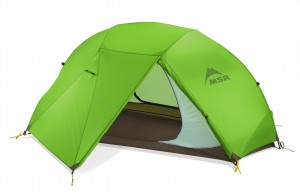 The Hoop has all you need to be comfortable, while still a reasonable weight to carry on a long trek. Dual doors and vestibule area make this tent feel a little bigger, and the 96-inch-long sleeping area accommodates taller campers (MSR says you can fit two large Therm-a-Rests). Set up couldn’t be simpler, thanks to all the pole segments (lateral and lengthwise) being connected as one unit. Canopy fabric is ripstop nylon; fly fabric is polyurethane and silicone coated. The Hoop has freestanding capability, so you don’t have to stake it.
The Hoop has all you need to be comfortable, while still a reasonable weight to carry on a long trek. Dual doors and vestibule area make this tent feel a little bigger, and the 96-inch-long sleeping area accommodates taller campers (MSR says you can fit two large Therm-a-Rests). Set up couldn’t be simpler, thanks to all the pole segments (lateral and lengthwise) being connected as one unit. Canopy fabric is ripstop nylon; fly fabric is polyurethane and silicone coated. The Hoop has freestanding capability, so you don’t have to stake it.
Minimum weight: 4 pounds, 8 ounces
Packaged weight: 5 pounds, 3 ounces
Local MSR retailers: Sam’s Outdoor Outfitters, Brattleboro; The Mountain Goat, Manchester; CC Outdoor Store, Waterbury.
For Extra Space
Nemo Asashi and Garage ($429.95 for tent; $159.95 for garage)
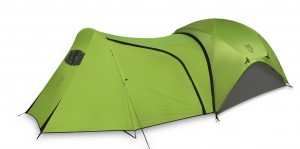 This is a camping cyclist’s dream come true. The New Hampshire–based company Nemo makes the Asashi and attachable garage, which allows you to protect your bike on your camping trip. Nicole Chretien, director of customer service at Nemo, says she always takes her bike camping with her, and that she fits three bikes, upside down, in the garage, while still maintaining easy access to the tent door. The tent itself sleeps four, and is made with mosquito-blocking mesh and polyurethaned nylon. The fly is also polyurethaned nylon.
This is a camping cyclist’s dream come true. The New Hampshire–based company Nemo makes the Asashi and attachable garage, which allows you to protect your bike on your camping trip. Nicole Chretien, director of customer service at Nemo, says she always takes her bike camping with her, and that she fits three bikes, upside down, in the garage, while still maintaining easy access to the tent door. The tent itself sleeps four, and is made with mosquito-blocking mesh and polyurethaned nylon. The fly is also polyurethaned nylon.
Minimum weight: 10 pounds, 8 ounces for tent
Packaged weight: 10 pounds, 15 ounces; 3 pounds, 12 ounces for garage
Local Nemo retailers: EMS, Manchester, Rutland, and South Burlington; CC Outdoor Store, Waterbury; Outdoor Gear Exchange, Burlington.
Winter/Altitude
Mountain Hardwear EV 2 $600
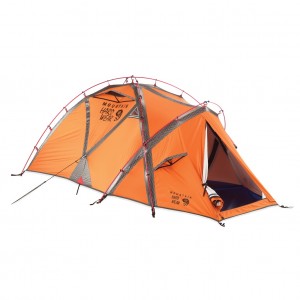 Named for Ed Viesturs, the EV series (available in two- or three-person versions) was designed to meet the mountaineer’s desire for a compact, light, strong, tent. Made for expeditions above 15,000 feet, the single-wall EV stands up to wind, and is easy to set up in windy conditions. Seams are welded for waterproofing. There’s 31 square-feet of floor space, a little snug for two people, but body heat is welcome if you’re using this tent for what it’s designed for.
Named for Ed Viesturs, the EV series (available in two- or three-person versions) was designed to meet the mountaineer’s desire for a compact, light, strong, tent. Made for expeditions above 15,000 feet, the single-wall EV stands up to wind, and is easy to set up in windy conditions. Seams are welded for waterproofing. There’s 31 square-feet of floor space, a little snug for two people, but body heat is welcome if you’re using this tent for what it’s designed for.
Minimum weight: 5 pounds, 3 ounces
Packaged weight: 5 pounds, 14 ounces
Local MH dealers: Onion River Sports, Montpelier; Lenny’s Shoe and Apparel, Barre and Williston; AJ’s Ski & Sport, Stowe; Farm-Way, Bradford; Dick’s Sporting Goods, Williston; The Alpine Shop, South Burlington; EMS Rutland and Manchester; Mountain Goat, Manchester; The Great Outdoors and The Boot Pro, Ludlow.
For the Family/Car Camping
This cabin-on-the-go is an excellent choice for entry-level campers or new camping families. At more than 6 feet tall, parents can stand upright, or close to it, and with 83 square feet of floor space, everyone can hang out and sleep comfortably in the Hobitat. Two doors keep things organized—maybe you’ll designate one door an in door and one an out door; or one a kid door and the other an adult door. It’s on the heavy side and is easier to set up with a buddy than alone, but this is the tent you’ll take to a family campground, not out in Patagonia.
Minimum weight: 18 pounds
Packaged weight: 20 pounds, 3 ounces
Online at www.rei.com
Single-Person Lightweight
Eureka! Solitaire Tent $84.90
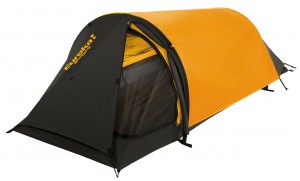 For the minimalist, Eureka’s Solitaire Tent is an easy choice. Low in weight and cost, the Solitaire is the most compact tent Eureka offers. The zipper is located on the roof, so you can unzip, stand up, and step out of the tent. There’s a total of just over 21 square feet of area, so not a lot of room for extra stuff, but you probably won’t want to lug too much extra weight if you’re backpacking anyway. No-see-um-proof mesh keeps this tent truly just for one.
For the minimalist, Eureka’s Solitaire Tent is an easy choice. Low in weight and cost, the Solitaire is the most compact tent Eureka offers. The zipper is located on the roof, so you can unzip, stand up, and step out of the tent. There’s a total of just over 21 square feet of area, so not a lot of room for extra stuff, but you probably won’t want to lug too much extra weight if you’re backpacking anyway. No-see-um-proof mesh keeps this tent truly just for one.
Minimum weight: 2 pounds, 9 ounces
Packaged weight: 5 pounds
Local Eureka dealers: Barre Army-Navy Store; Caplan’s, Morrisville; Dick’s Sporting Goods, Plattsburgh, N.Y., Williston, and Rutland; Outdoor Gear Exchange, Burlington; Gander Mountain, Plattsburgh, N.Y.

